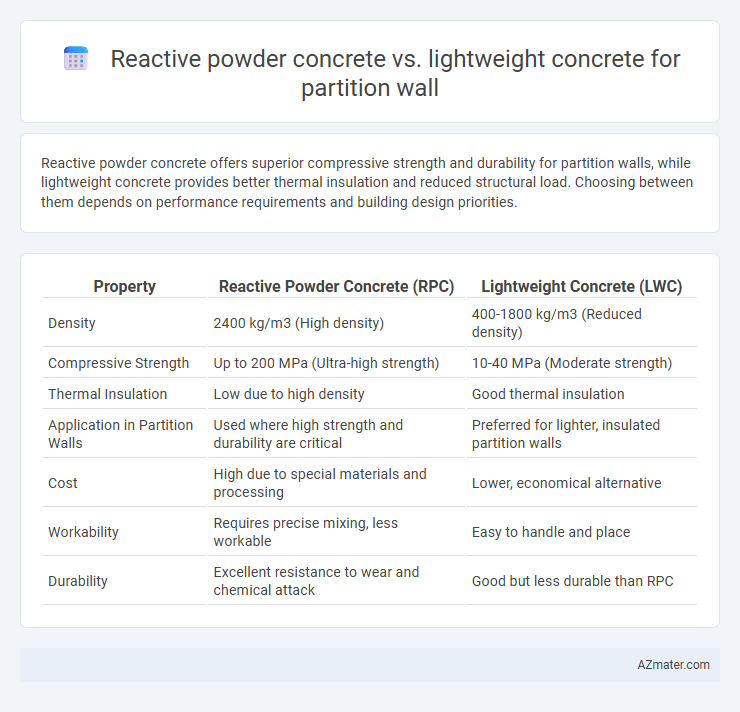Reactive powder concrete offers superior compressive strength and durability for partition walls, while lightweight concrete provides better thermal insulation and reduced structural load. Choosing between them depends on performance requirements and building design priorities.
Table of Comparison
| Property | Reactive Powder Concrete (RPC) | Lightweight Concrete (LWC) |
|---|---|---|
| Density | 2400 kg/m3 (High density) | 400-1800 kg/m3 (Reduced density) |
| Compressive Strength | Up to 200 MPa (Ultra-high strength) | 10-40 MPa (Moderate strength) |
| Thermal Insulation | Low due to high density | Good thermal insulation |
| Application in Partition Walls | Used where high strength and durability are critical | Preferred for lighter, insulated partition walls |
| Cost | High due to special materials and processing | Lower, economical alternative |
| Workability | Requires precise mixing, less workable | Easy to handle and place |
| Durability | Excellent resistance to wear and chemical attack | Good but less durable than RPC |
Introduction to Partition Wall Materials
Partition walls require materials that balance strength, durability, and weight. Reactive powder concrete (RPC) offers exceptional compressive strength and durability due to its dense microstructure and ultrafine particles, making it suitable for high-load partition applications. Lightweight concrete, characterized by low density and thermal insulation properties, is favored for reducing dead loads and improving energy efficiency in partition walls.
What is Reactive Powder Concrete (RPC)?
Reactive Powder Concrete (RPC) is an ultra-high performance concrete characterized by its dense microstructure, achieved through a mix of fine powders such as silica fume, cement, and quartz sand, combined with steel fibers for enhanced tensile strength. It exhibits exceptional compressive strength exceeding 200 MPa, superior durability, and low permeability, making it ideal for thin, load-bearing partition walls that require both strength and reduced thickness. In contrast to Lightweight Concrete, which prioritizes reduced density and thermal insulation, RPC offers superior mechanical properties but at a higher material cost and weight.
Key Features of Lightweight Concrete
Lightweight concrete is characterized by reduced density, typically ranging from 800 to 1,600 kg/m3, making it ideal for partition walls where weight reduction is crucial. Its improved thermal and acoustic insulation properties enhance energy efficiency and soundproofing in building interiors. Unlike reactive powder concrete, lightweight concrete offers easier handling and cost-effective application without compromising structural integrity for non-load-bearing partitions.
Strength Comparison: RPC vs Lightweight Concrete
Reactive powder concrete (RPC) exhibits significantly higher compressive strength, often exceeding 150 MPa, compared to lightweight concrete, which typically ranges between 10 to 30 MPa. The dense microstructure of RPC, achieved through ultrafine powder particles and reduced porosity, provides superior mechanical performance and durability for partition walls. Lightweight concrete prioritizes reduced weight and thermal insulation but compromises on load-bearing capacity relative to RPC.
Durability and Longevity
Reactive powder concrete (RPC) offers superior durability and longevity compared to lightweight concrete for partition walls due to its ultra-high strength, dense microstructure, and enhanced resistance to cracking and chemical attacks. Lightweight concrete, while providing thermal insulation and reduced dead load, typically exhibits lower compressive strength and higher permeability, resulting in reduced durability over time. For partition walls requiring extended service life and minimal maintenance, RPC is the more reliable choice due to its enhanced mechanical properties and resistance to environmental degradation.
Weight and Load Implications
Reactive powder concrete (RPC) offers high compressive strength with a density typically around 2400 kg/m3, resulting in a heavier partition wall compared to lightweight concrete, which has densities ranging from 800 to 1600 kg/m3. The increased weight of RPC partitions significantly impacts structural load, requiring stronger supporting frameworks and foundations. Lightweight concrete reduces dead load, improving seismic performance and enabling cost savings in structural design for partition walls where lower weight is critical.
Thermal and Acoustic Insulation Properties
Reactive powder concrete (RPC) offers superior compressive strength and durability but has lower thermal and acoustic insulation properties compared to lightweight concrete, which features enhanced thermal resistance and sound absorption due to its porous aggregate structure. Lightweight concrete significantly reduces heat transfer and noise transmission, making it more effective for partition walls requiring efficient insulation. For optimal energy efficiency and acoustic comfort, lightweight concrete is generally preferred over RPC in partition wall applications.
Cost Considerations
Reactive powder concrete (RPC) typically incurs higher material and production costs due to its advanced composition, including fine powders and steel fibers, making it less economical for partition walls. Lightweight concrete offers significant cost savings through reduced material density, lower transportation expenses, and easier handling during construction. Evaluating overall project budgets, lightweight concrete generally provides a more cost-effective solution for partition walls without compromising essential structural requirements.
Installation and Workability
Reactive powder concrete (RPC) offers superior compressive strength and durability for partition walls but requires skilled labor and controlled curing conditions, making installation more demanding compared to lightweight concrete. Lightweight concrete excels in workability due to its lower density and ease of cutting and shaping, enabling faster installation and reduced labor costs for partition walls. For projects prioritizing quick installation and flexibility, lightweight concrete is preferable, while RPC is suited for high-performance applications requiring structural robustness.
Best Applications for Partition Walls
Reactive powder concrete offers exceptional strength and durability, making it ideal for load-bearing partition walls that require high structural performance and resistance to impact. Lightweight concrete excels in thermal insulation and soundproofing, providing energy-efficient and acoustically comfortable partition walls suitable for residential and office interiors. Choosing between these materials depends on specific needs: reactive powder concrete for strength-intensive applications and lightweight concrete for enhancing energy efficiency and comfort.

Infographic: Reactive powder concrete vs Lightweight concrete for Partition wall
 azmater.com
azmater.com